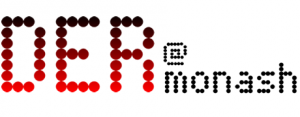Author:
Andrew Hope
 On 6 June The Guardian and The Washington Post newspapers reported that under a programme known as Prism the National Security Agency and the Federal Bureau of Investigation were tapping into United States (US) internet companies to monitor online communication. Also in June 2013 results from Australian SafeGov survey of about 1000 parents were released, showing that more than 90% of respondents were against online data tracking in schools. Whilst these two news items might initially seem unconnected they both serve to illustrate the growing importance of surveillance focusing upon what could be broadly labelled as cloud computing, wherein data or programs are stored and accessed over the internet.
On 6 June The Guardian and The Washington Post newspapers reported that under a programme known as Prism the National Security Agency and the Federal Bureau of Investigation were tapping into United States (US) internet companies to monitor online communication. Also in June 2013 results from Australian SafeGov survey of about 1000 parents were released, showing that more than 90% of respondents were against online data tracking in schools. Whilst these two news items might initially seem unconnected they both serve to illustrate the growing importance of surveillance focusing upon what could be broadly labelled as cloud computing, wherein data or programs are stored and accessed over the internet.
Educational institutions may currently store data and install programs on their own internet servers, but given possible economies of scale, improved manageability and lower maintenance costs, there is a growing clamour for them to utilise cloud computing. Although much of this talk focuses on learning, it should be noted that there is also the potential to use the ‘cloud’ to access management software and store administrative data.
Discussions about surveillance technologies in schools tend to focus on visible observational artefacts such as Closed Circuit Television cameras, Automated Fingerprint Identification Systems, iris / vein scanning devices and metal detectors. Yet, what Clarke (1988, p.499) labelled as dataveillance, ‘the systematic use of personal data systems in the investigation or monitoring of the actions or communications of one or more persons’, has grown exponentially in recent years. Whilst educational institutions have traditionally gathered data on attendance, grades and serious incidents of misbehaviour, the development of statistical software and new information systems has extended the size, scope and function of these surveillance technologies.
As Selwyn (2011) infers such data systems have expanded to include a networked focus upon presence (attendance, registration and admissions), finance (payrolls, budgeting and accounting), organisation (lesson timetabling, scheduling and planning) as well as activities related to learning (school intranet, weblogs, learning management systems, Virtual Learning Environments, student dashboards, metrics and performance feedback). Given the range and depth of such information it is not a stretch of the imagination to suggest the emergence of the ‘database school’ in which information stored on ‘clouds’ is used as part of the everyday monitoring processes.
Insofar as surveillance can be misused to facilitate oppressive control or commercial exploitation, it is important to consider what the actual impacts of online dataveillance might be for students and schools. Inevitably there are issues of privacy, liberty and efficacy that need to be addressed. Of perhaps more significance though are questions related to how information held on databases will be used to construct student, consumer or citizen profiles. Internet based ‘data doubles’ could emerge, identities that unbeknown to individuals start to have a very real effect on their everyday life. School records relating to attendance, behaviour and (under)achievement might follow students as a matter of course in a manner previously considered impractical, impacting upon their academic opportunities. Educational institutions and employers could seek to access such ‘cloud’ based identities, using them as part of a selection process. If this seems fanciful it is worth noting that some businesses and colleges are already demanding access to applicants Facebook accounts to screen for potentially damaging material. Furthermore, it is not only educational establishments that store information about students. Albeit within the confines of legal frameworks, government bodies and commercial organisations increasingly collect and sort data about schoolchildren.
Obviously, the gathering of data does not itself determine whether it will be used and, if so, in what manner. After all, ‘surveillance slack’ can occur, wherein the actual use of surveillance technology is less than its full potential. Nonetheless, as powerful, relatively inexpensive, easy-to-use data analysis tools are made available there is the alternative possibility of ‘function creep’, with data collected to fulfil one purpose being subsequently utilised for an entirely different end. Indeed the analysis of educational data currently goes well beyond producing merely descriptive outputs, occasionally seeking to anticipate reality aided by forms of diagnostic surveillance. With the use of student ‘threat’ evaluation software and predictive analytics anticipating dropout, online data about students might increasingly generate simulations that ensnare students in a statistically predicted future. Rather than educational organisations reacting solely to student behaviour they might instead initiate interventions in response to the appearance of online prognostic data. Thus ‘clouds’ could reign over people, as surveillance of internet-based, simulated ‘data doubles’ come to influence students’ life chances to a much greater extent than has previously been the case.
If this appears somewhat dystopian it should also be noted that databases can confer credibility. Indeed surveillance might be tolerated because data can be traded for greater security or better prospects. Hence ‘successful’ students could utilise their data profile to access new opportunities and benefits. Yet, conformity might simply mask the spectre of resistance, as individuals aware of the importance of data stored in ‘clouds’ knowingly seek to construct ‘positive’ simulacra, data images of themselves that will increase their academic, social and economic prospects. Thus, they could engage in a playful subversion of ‘cloud’ based surveillance, resisting through ‘gaming the system’. Indeed it has long been suggested that whilst schools are institutions of control they also breed cultures of resistance that may have a purpose in wider society. Consequently, although educational establishments are inherently surveillance environments, they may also be the training grounds for students to learn, not only how to be surveilled, but also how to resist. Ultimately in a world increasingly characterised by the need to effectively manage public data profiles, schools may unintentionally allow students to learn how to construct ‘positive’ ‘data doubles’, whilst concealing nefarious online activities deep within the ‘clouds’.
About the author
Associate Professor Andrew Hope is a leading expert at the nexus of educational technology in schools, young people and risk. His work in exploring issues of social control, school surveillance, illicit use of technology, and student risk taking is internationally well regarded. His profile can be found at: http://www.adelaide.edu.au/directory/andrew.hope.
References
Clarke, R. (1988) Information technology and dataveillance. Communications of the ACM. 31(5), 498-512.
Selwyn, N. (2011) ‘It’s all about standardisation’ – Exploring the digital (re)configuration of school management and administration. Cambridge Journal of Education, 41(4), 473-488



